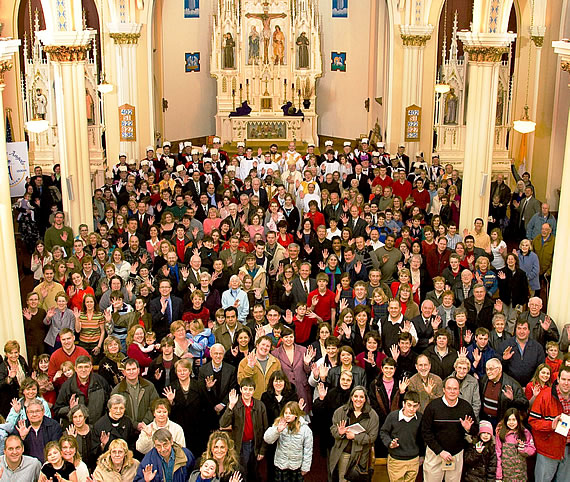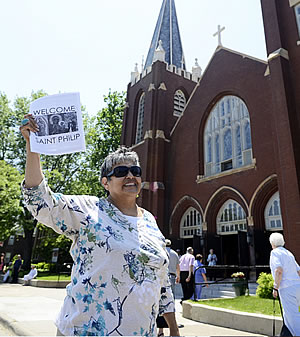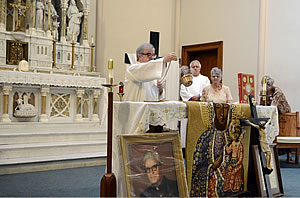So, technically, this doesn’t quite qualify as a flash mob, but I love it nonetheless. The video features two Capuchin Franciscan friars (I’m guessing that they could be from this friary) who bring the body of Jesus Christ in the Eucharist right into the center of Preston, England’s marketplace. While one friar recites a litany of Christ’s titles, the other friar holds up Christ in the monstrance. The monk who is speaking into the amplifier repeatedly says, “Come and kneel before Him now,” and it’s truly beautiful to see people in the midst of their shopping, stopping to kneel before the Lord. Others laugh, while still others stand with puzzled looks on their faces.
It’s an appropriate video before the Feast of Corpus Christi, a feast upon which many parish priests still lead public Eucharistic processions. We desperately need to bring Christ back out into the streets and the marketplaces and the public square.
Here’s what the friar recites before the crowd. I did my best to transcribe it, but missed a few words at the end.
“Jesus Christ is in every book of the Bible.
In Genesis, Jesus is the Seed of the Woman.
In Exodus, He is the Passover Lamb.
In Leviticus, He is the Priest, the Altar, and the Lamb of Sacrifice.
In Numbers, He is a Pillar of Cloud by day and the Pillar of Fire by Night.
In Deuteronomy, Jesus is the Prophet, like Moses.
Come and kneel before Him now.
In Joshua, Jesus is the Captain of Our Salvation.
In Judges, He is our Judge and Lawgiver.
In Ruth, He is our Kinsman and Redeemer.
In 1 and 2 Samuel, He is our Trusted Prophet.
In Kings and Chronicles, He is our Reigning King.
In Ezra, He is the rebuilder of the broken down walls of human life.
Come and kneel before Him now.
In Nehemiah, Jesus is our Restorer.
In Tobit, He is the Messenger of New Life.
In Judith, He is Weakness Turned into Victory.
In Esther, He is our Advocate.
In 1 and 2 Maccabees, He is the Leader who dies for God’s law.
Come and kneel before Him now.
In Job, Jesus is our Everliving Redeemer.
In Psalms, He is our Shepherd.
In Proverbs, He is our Wisdom.
In Ecclesiastes, He is our Hope of Resurrection.
In the Song of Songs, He is our Loving Bridegroom.
In Wisdom, He is the emanation of God’s thought.
In Ecclesiasticus (Sirach), Jesus is our security.
Come and kneel before Him now.
In Isaiah, Jesus is the Suffering Servant.
In Jeremiah, He is the Righteous Branch.
In Lamentations, He is our Weeping Prophet.
In Baruch, He is the Mercy from the Eternal One.
In Ezekiel, He is the One with the Right to Rule.
In Daniel, Jesus is the Fourth Man in the fiery furnace.
Come and kneel before Him now.
In Hosea, Jesus is the Faithful Husband forever married to the sinner.
In Joel, He is the One who Baptizes with the Holy Spirit of Fire.
In Amos, He is the Restorer of Justice.
In Obadiah, He is Mighty to Save.
In Jonah, He is our great foreign missionary.
In Micah, He is the feet of one who brings Good News.
Come and kneel before Him now.
In Nahum, Jesus is our stronghold in the day of trouble.
In Habakkuk, He is God my Savior.
In Zephaniah, He is the King of Israel.
In Haggai, He is the signet ring.
In Zechariah, He is our Humble King riding on a colt.
In Malachi, Jesus is the Son of Righteousness.
Come and kneel before Him now.
In Matthew, Jesus is God with us.
In Mark, He is the Son of God.
In Luke, He is the Son of Mary, feeling what you feel.
In John, He is the Bread of Life.
In Acts, Jesus is the Savior of the World.
Come and kneel before Him now.
In Romans, Jesus is the Righteousness of God.
In 1 Corinthians, He is the Resurrection.
In 2 Corinthians, He is the God of all comfort.
In Galatians, He is your liberty. He sets you free.
In Ephesians, Jesus is the Head of the Church.
Come and kneel before Him now.
In Philippians, Jesus is your Joy.
In Colossians, He is your Completeness.
In 1 and 2 Thessalonians, He is your Hope.
In 1 Timothy, He is your Faith.
In 2 Timothy, Jesus is your Stability.
Come and kneel before Him now.
In Titus, Jesus is Truth.
In Philemon, He is your Benefactor.
In Hebrews, He is your Perfection.
In James, He is the Power behind your Faith.
In 1 Peter, He is your Example.
In 2 Peter, Jesus is your Purity.
Come and kneel before Him now.
In 1 John, Jesus is your Life.
In 2 John, He is your Pattern.
In 3 John, He is your Motivation.
In Jude, He is the Foundation of your Faith.
In Revelation, Jesus is your Coming King.
He is:
The First and the Last.
The Beginning and the End.
He is the Keeper of Creation and the Creator of All.
He is the Architect of the Universe and the Manager of All Time.
He Always Was, He Always Is, and He Always Will Be Unmoved, Unchanged, Undefeated, and Never Undone.
He was bruised and brought healing.
He was pierced and eased pain.
He was persecuted and brought freedom.
He was dead and brought life.
He is risen and brings power.
He reigns and brings peace.
The world can’t understand Him.
The armys can’t defeat Him.
Schools can’t explain Him and the leaders can’t ignore Him.
Herod couldn’t kill Him.
The Pharisees couldn’t confuse Him.
The people couldn’t hold him. [This is where the clapping begins]
Nero couldn’t crush Him.
Hitler couldn’t silence Him.
The New Age can’t replace Him.
And Oprah can’t explain Him away.
He is Life, Love, Longevity, and Lord.
He is Goodness, Kindness, Gentleness and God.
He is Holy, Righteous, Mighty, Powerful, [missing word]
His Ways our Right, His Words Eternal, His Rules Unchanging, and His
Might [missing phrase]
He is My Redeemer, He is My Savior, He is My God, He is My Priest, He is My Joy, He is My Comfort, He is My Lord, and He rules my life.”
The astute reader will quickly realize that the phrases relate to the Books of the Holy Bible









